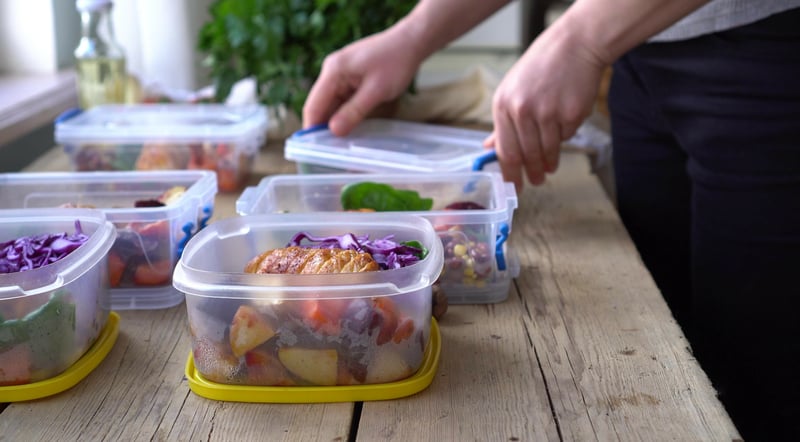
Whether you’re looking for ways to save money or focus on eating healthy, meal prepping is one of the most important steps any college student can take.
Preparing your meals in advance means that you’ll save time worrying about your meals throughout the week. Why? Because you’ll do your planning in advance.
Whether you’re new to meal prepping or just want a refresher, here are five simple steps for starting.
Step 1: Evaluate your dietary needs, restrictions and goals
Your first step should be to consider what your dietary needs are, whether you have any eating restrictions and what your goals for meal prepping are. If you’re hoping to reduce your sugar intake, for example, keep this in mind while you select recipes. If your biggest goal is to reduce your food expenses, you’ll want to focus on that as you prepare your meal plan.
Step 2: Create a plan and get organized
When you’re ready to start meal planning, it’s important to start with some self-reflection.
“You’ll need to do an honest self-evaluation,” said Bryan Severns, food programs manager at K-State Olathe and director of the Food Innovation Accelerator. “Ask yourself, ‘Will I really eat this?’ You also need to consider whether you’re OK eating leftovers because that’s what meal prepping is. You’re creating leftovers."
One of the biggest mistakes new meal planners make is to choose large, complicated meals that they don’t already enjoy. This is a quick way to end up with a lot of wasted food, so make sure you select meals that you’re already familiar with and know that you'll eat.
In addition to flavor, consider meals that are easy to store and reheat.
“Cauliflower rice, quinoa, beans and lentils can be found already cooked. All you need to do is reheat them, which helps with your meal prep and saves time,” said Matt Arnold, food programs and services coordinator at K-State Olathe. “When I meal prep, I often braise meat. This might be six chicken breasts or two pounds of beef. Once I braise them, I can just pull the meat apart. You can use this for pasta or tacos. It becomes very versatile.”
This versatility, Severns says, is key.
“You don’t have to prepare everything in advance. You can prep your pasta sauce in advance and freeze it, for example, but then make your pasta fresh with each meal,” said Severns.
Once you’ve selected your meals for the week, it’s time to take your planning to the next level: preparing to head to the grocery store. For many college students, the process of grocery shopping can be frustrating. Prices may be higher than you want and store layouts can be overwhelming. Arnold suggested students plan their grocery store route in advance to minimize shopping time and to ensure they don’t miss anything.
“Organize your shopping list by categories the way you do in kitchens,” said Arnold. “Break things down by categories. When you arrange your shopping list by protein, dairy or produce, you can grab each item you need before moving on to the next section of the grocery store. This saves you time and reduces stress.”
As a busy college student, you have enough stress on your plate without worrying about taking too much time at the store, so be sure to prepare a careful list before you even begin your shopping.
Step 3: Approach cooking as an experience, not a chore
One of the biggest things that holds back meal preppers is viewing cooking as a chore that must be completed quickly and efficiently, rather than an experience where you get to enjoy spending time in the kitchen.
“It’s important to set aside a day each week for cooking your meals,” said Arnold. “You can prepare multiple meals at the same time and eat those throughout the week.”
If you’re juggling classes, homework, family commitments and a job, you may find that the idea of preparing your meals in advance can be overwhelming. Viewing this as a relaxing way to spend a Sunday afternoon, rather than a chore that must be completed, is one of the best ways to ensure you stick with your meal planning.
“The time commitment for cooking one meal is similar to the time it takes to prepare three,” said Severns. “At my house, we always make enough soup for three or four meals. This means we’re eating the same thing, but we only have to prepare it once.”
Another way you can approach cooking as an experience is to prepare meals that have memories attached to them.
“A lot of college students miss home,” said Arnold. “Think about meals that your mom or grandma made that you’re particularly fond of. Try to duplicate them. You might not be able to at first, but it’s a great place to start.”
Step 4: Store your food properly
You don’t have to buy fancy containers for storing your prepped food, but you should store it properly.
“You can reuse containers you already have,” said Severns. “Yogurt or deli meat containers work well.”
Once you prep your meals, it’s important to get them cold as fast as possible. If you’re working with hot food, Severns and Arnold suggest putting your meals in the fridge or freezer without the lid on. Once the meals cool, you can add the lid. This ensures that the food stores properly and lasts longer.
It’s also important to make sure that you label everything you make.
"You can’t label enough," said Severns. “Not just the date. Be sure to write down what’s inside each container because you will not remember what it is.”
Step 5: Stay focused
When you’re creating meals in advance, you need to focus on your goals.
“That prepped meal in the fridge is competing with your friend saying, ‘let’s go grab a sandwich,’” said Severns. “There will always be someone who wants to grab pizza or go out to eat, so make sure you’re preparing meals that you really enjoy and that you’re willing to eat.”
At the end of the day, what meal planning comes down to is determination. If you’re willing to spend time in advance planning out what you’ll eat, this is an effective way to ensure you’re getting the nutrients you need, meeting your dietary needs and reducing the amount of money you spend eating out at restaurants.
Remember that you don’t need expensive kitchen equipment or cooking experience to meal prep as a college student.
“Keep it simple,” said Severns. “Don’t be too fancy.”
Learn more about our kitchens team when you visit us online.
Explore the K-State Olathe kitchens
Our kitchens provide a launch pad for businesses that want affordability and low-risk. Our shared kitchen space provides safe food storage, grease removal, a dynamic food scene and an opportunity to network with fellow culinarians. Additionally, we boast a chef-grade state-of-the-art kitchen space with innovation to thrive.


